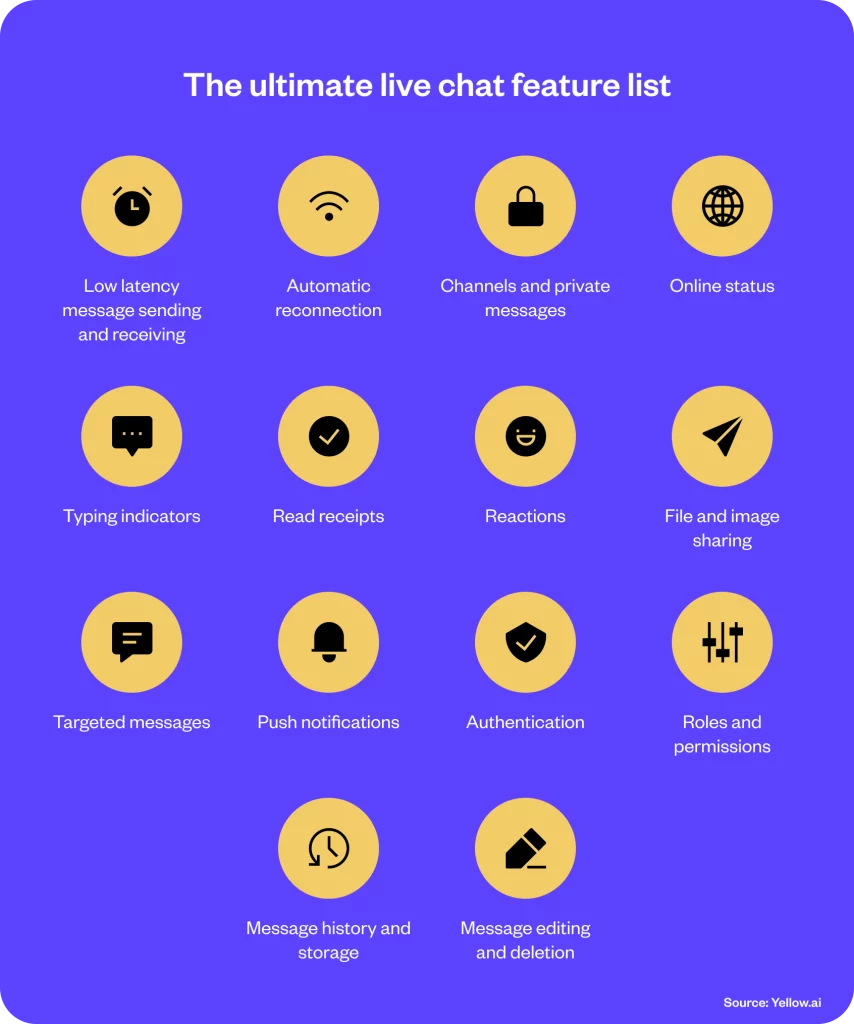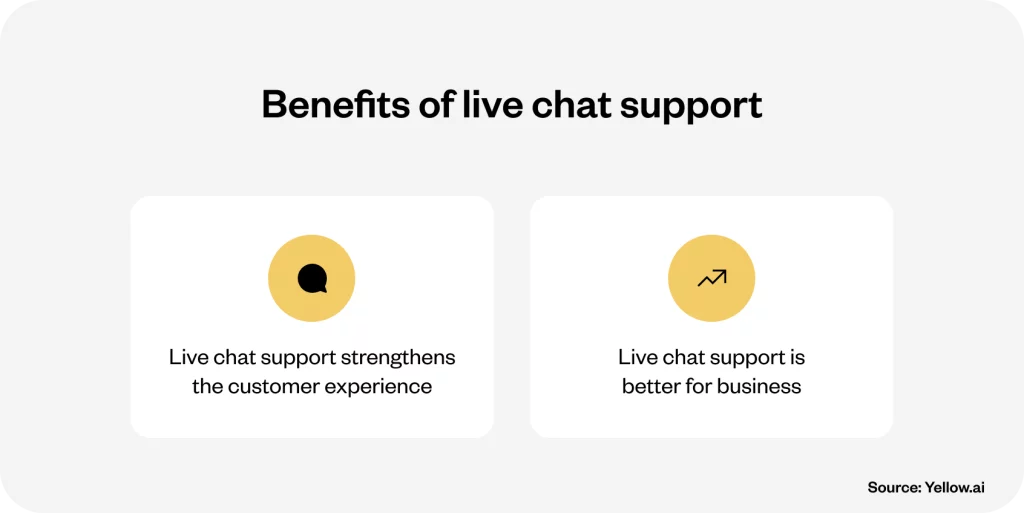Executive summary
We are in an age where communication reigns supreme. Live chat has emerged as a crucial tool for enhancing customer interaction and support. This comprehensive blog navigates through the essence of live chat, its operational intricacies, and groundbreaking features. We’ll explore the nuanced dance between live chat and chatbots in customer service, revealing the undeniable benefits of live chat for businesses. Additionally, we spotlight how AI elevates the live chat landscape, offering businesses a roadmap to integrate advanced AI chatbots for enriched customer interactions seamlessly.
Introduction
Step into a scenario where every customer interaction is an opportunity for your business to shine. Picture this: A frustrated customer clicks the live chat button on your website. In moments, they’re greeted not merely with automated responses but with empathy, efficiency, and expert solutions tailored to their needs. That’s the transformative power of live chat today. With a whopping 92% customer satisfaction rate, live chat fulfills basic expectations and creates a new paradigm in customer engagement.
Live chat has evolved from a simple, text-based solution to a sophisticated, AI-driven powerhouse. Gone are the days of simple text exchanges; today’s live chat platforms are sophisticated, AI-enhanced systems that understand nuances, anticipate needs, and provide solutions in real time. It’s a game-changer for businesses, blending technology’s efficiency with a human touch. As we explore the intricacies of live chat, this blog will explain how businesses can leverage this powerful tool to meet and exceed customer expectations, creating memorable experiences that foster loyalty and growth.
Related must-reads:
- How to create a chatbot – Business owner guide 2024
- 11 essential chatbot features to consider in 2024
- 9 Real-life chatbot examples [well-known brands]
- Chatbot design – How to design a successful chatbot?
What is live chat?
Live chat represents the cutting edge of customer communication in the digital era, a tool that instantly bridges the gap between businesses and their customers. At its essence, live chat is an online customer messaging system seamlessly integrated within a company’s website, acting as a conduit for direct and immediate dialogue. It’s more than just a pop-up window; it’s a dynamic interface where customers engage with company representatives across various roles, from customer service to technical support.
Unlike the passive nature of emails or the often frustrating hold times of phone calls, live chat provides instant connectivity. It can be triggered by customer action or appear proactively, a strategic move to enhance engagement. As a pivotal component of modern SaaS (software as a service) infrastructure, live chat is becoming a non-negotiable asset for businesses aiming to meet and exceed the evolving expectations of their customers.
But what really sets live chat apart? It’s the immediacy and personalization it offers. Customers no longer need to navigate away from your page to seek help. Whether they initiate the conversation or a proactive chat window pops up offering assistance, the message is clear: you’re there to help, right there and then, turning every interaction into an opportunity to impress and retain customers.
How does live chat work?
Let’s break down the workings of live chat, a tool that’s reshaping customer service. Picture this: A customer lands on your website, and there, in the corner of the screen, is a small chat icon, a hidden gateway to actual human interaction. That is where live chat begins its work. It’s integrated into your website, so there’s no hassle of downloading anything. With just a click, customers are connected and ready to chat.
The live chat window is intuitive, resembling the chat apps everyone’s familiar with. Customers can type out their queries and even attach images or documents for clarity to make the conversation feel more personal. This convenience and familiarity sets live chat apart.
Related read: Live Chat Integration on app.yellow.ai
On the flip side, your support staff have various features at their fingertips. They can peek into the customer’s journey on your site, which helps them understand the context better. They have quick responses ready for common questions, saving precious time. But the real game-changer? They can see what the customer is typing as they type. This feature is about empathy and understanding the customer’s issue even before they’ve hit ‘send.’
And it’s not just bound to desktop interactions. Live chat extends its reach to mobile platforms, too, ensuring that your team is connected, no matter where they are. This versatility is crucial in today’s mobile-first world. The power to moderate conversations helps maintain a quality experience for everyone. If the customer has chatted before, being able to pull up previous conversations is invaluable – it’s like picking up an ongoing conversation with an old friend, where you never really feel like a stranger.
But think beyond just the conversation. Live chat is a goldmine of data and insights. Each chat is an opportunity to learn more about your customers – what troubles them, what delights them. Besides being a tool for problem-solving, it’s a lens into the heart of your customer experience. For businesses, it’s a bridge to their customers, a path to understanding them better, and a step towards creating a truly customer-centric business.
Equip your support team with generative AI-powered inbox

The ultimate live chat feature list
The world of live chat is not just about sending and receiving messages. It’s a complex interplay of features and functionalities that enhance user experience and efficiency. Let’s explore some of the key features that define today’s live chat platforms:

1. Low latency message sending and receiving
The backbone of any effective live chat system is its ability to deliver messages with minimal delay. Low latency is critical in maintaining a fluid, conversation-like experience. Moreover, in fast-paced business environments, where every second counts, this feature becomes vital in providing timely responses and resolutions to customer inquiries. A delayed response can mean the difference between a satisfied customer and a lost opportunity. This feature ensures that communication feels as real and immediate as a face-to-face conversation, keeping the human touch intact.
The underlying technology that supports low-latency messaging is robust and sophisticated. It ensures that messages are sent and received quickly and also securely. This technology is essential for businesses that aim to build trust and reliability with their customers, as it guarantees that communication is efficient, confidential, and uninterrupted.
2. Automatic reconnection
Reliability is vital in live chat interactions. Automatic reconnection in live chat ensures that conversations aren’t lost in the event of connectivity issues. This feature gracefully handles interruptions, seamlessly restoring chat sessions, thereby preserving the flow of conversation. It maintains the continuity of communication, preventing customer frustration and ensuring that support staff can seamlessly continue their assistance without missing a beat.
3. Channels and private messages
Flexibility in communication is vital. Live chat offers both public channels for broader interactions and private messaging for more confidential or targeted conversations. This dual functionality allows businesses to segment and manage customer interactions based on context and privacy requirements. Channels can be used for general queries or discussions, while private messages handle sensitive information or specific customer issues.
Incorporating these public and private modes of communication within a single platform provides a versatile and comprehensive tool for customer engagement. It allows businesses to cater to different types of inquiries efficiently, enhancing the overall customer service experience.
4. Online status
Visibility of online status is a small but significant feature. It lets users know if the person on the other end is available. The online status feature informs customers about the availability of support staff, setting realistic expectations for response times.
It’s a simple yet effective way to manage customer interactions, ensuring that customers are aware of when they can expect a reply. This feature also helps customer service teams manage their workload more efficiently, allowing them to prioritize and respond to customer inquiries in real-time.
5. Typing indicators
Communication is about cues, and typing indicators in live chat provides a crucial one. They offer a glimpse into the responsiveness of the conversation, letting customers know that their queries are being addressed. This visual cue mimics the natural rhythm of a conversation, maintaining engagement and reducing the perceived waiting time.
It’s a small yet impactful feature that adds to the dynamism of live chat, making digital conversations feel more personal and attentive.
6. Read receipts
Accountability and acknowledgment are crucial in any conversation. The read receipts in live chat ensure that the sent messages are also acknowledged. This feature provides transparency and helps to set clear expectations on both sides of the conversation. For customers, it’s a confirmation that their message has been seen and is being acted upon. For businesses, it’s a tool to track engagement and ensure that no customer query goes unnoticed.
7. Reactions
Expressing emotions is a part of human interaction. Reactions, such as emojis and GIFs, allow for a more expressive and engaging conversation in live chat. They add a layer of emotion and personality to chats, making interactions more relatable and human. This feature is particularly useful in softening the tone of the conversation and adding a touch of warmth to digital communication.
8. File and image sharing
The ability to share files and images directly within the chat window enhances the functionality of live chat. This feature allows for a more comprehensive exchange of information, whether it’s sharing product images, documents, or screenshots to assist in troubleshooting. It streamlines the problem-solving process, making it more efficient and effective.
This feature lets businesses improve the quality of service and customer satisfaction. It also reduces the need for multiple communication channels, consolidating interactions within the live chat platform.
9. Targeted messages
Targeted messages in live chat allow for direct communication with specific individuals or groups, ensuring that messages reach the intended audience without getting lost in the chatter. This feature is handy in group chat settings or when needing to address specific customer issues directly.
10. Push notifications
Push notifications in live chat keep users informed and engaged, even when they’re not actively on the platform. These notifications alert users to new messages or updates, ensuring that critical communications are not missed. It’s about maintaining a continuous connection with customers and enhancing responsiveness and engagement.
11. Authentication
Authentication in live chat safeguards conversations, ensuring that they are secure and that users are who they claim to be. This feature is crucial in maintaining the integrity and privacy of interactions, providing a secure environment for both customers and businesses.
12. Roles and permissions
Managing a live chat environment effectively requires control and customization. The roles and permissions feature allows businesses to define access levels and control what each user can see and do within the chat. It helps in maintaining order and ensuring that the chat environment is managed effectively, particularly in larger organizations or customer service teams.
13. Message history and storage
Accessibility to past conversations is invaluable in maintaining continuity and context in interactions. Message history and storage in live chat provide a record of previous conversations, which can be referenced for context, follow-up, or to track the progress of customer issues. This feature ensures that no detail is lost and that conversations can be picked up where they left off.
14. Message editing and deletion
Flexibility is essential in communication, and the ability to edit or delete messages in live chat allows for corrections and updates, ensuring that the conversation remains relevant and precise. This feature is particularly useful in professional settings, where accuracy and clarity are paramount.
Benefits of live chat support
The integration of live chat support into a business’s customer service arsenal is a strategic move that fundamentally enhances the customer experience and boosts business operations. Given below are the two primary benefits of live chat support.

1. Live chat support strengthens the customer experience
Customers seek immediate solutions as they prefer quick, hassle-free interactions, and live chat perfectly caters to this need. According to a 2020 Customer Experience Trends Report, 28% of people expect a reply on chat within five minutes, highlighting the importance of rapid response in customer service.
Related read: Conversational AI for Customer Experience?
Live chat transcends traditional communication barriers like phone tags or the delayed back-and-forth of emails. It enables customers to receive assistance in real-time, directly on the website, without the inconvenience of navigating away from their current page. This seamless integration of support within the customer’s browsing experience not only streamlines issue resolution but also enhances the overall brand experience.
Furthermore, live chat provides a comprehensive context for each customer interaction. Unlike phone calls, live chat sessions can include links, documents, and screenshots, offering a richer, more informed support experience. This level of detail and the ability to address issues promptly and efficiently can significantly elevate customer satisfaction and foster long-term loyalty.
2. Live chat support is better for business
Adopting live chat support enables businesses to scale their customer support operations effectively, catering to a larger audience without a proportional increase in resources or complexity. Live chat’s multitasking capability allows agents to assist multiple customers simultaneously, reducing wait times and increasing overall efficiency.
From a strategic standpoint, live chat can help businesses meet and exceed service-level agreements. The immediacy of live chat reduces response times significantly compared to phone or email support, ensuring quicker resolutions and higher customer satisfaction rates. This efficiency is crucial for businesses aiming to maintain high standards of customer service and responsiveness.
Moreover, live chat empowers businesses to address customer issues, often before they escalate proactively. By engaging with website visitors or app users in real-time, businesses can identify and resolve problems swiftly, preventing minor issues from turning into significant customer dissatisfaction. This proactive approach to customer service enhances the immediate customer experience and contributes to building a reputation for reliability and responsiveness.
Related read: What is customer service automation [+7 benefits]
Chatbot vs live chat: Which is better for customer service?
Live chat, powered by human agents, offers a level of empathy, understanding, and personal connection that chatbots strive to match. It’s the human element that often makes the difference in complex or sensitive situations where nuanced understanding and emotional intelligence are paramount. However, live chat is constrained by agent availability and can sometimes struggle with the volume and immediacy of responses, especially during peak times.
Related read: Chatbot vs live chat: Which is better for customer service?
AI chatbots, on the other hand, excel in providing instant responses and handling multiple queries simultaneously, making them ideal for addressing common, straightforward questions efficiently. They offer consistency in responses and are available 24/7, ensuring that customer queries are never left unanswered, regardless of the time or day. However, chatbots may lack the nuanced understanding and personalization that live agents bring, especially in complex scenarios.
Here is a comparative analysis of chatbots and live chat across various aspects:
| Aspect | AI Chatbot | Live Chat |
| Availability | 24/7 without any breaks | Limited by agent availability |
| Response Time | Immediate responses | Dependent on agent availability and workload |
| Scalability | Can handle multiple queries simultaneously | Limited to a few chats per agent |
| Personalization | Uses data to provide personalized responses, instantly | Deep personalization based on the agent’s knowledge and experience |
| Consistency | Offers consistent information every time | Can vary based on the agent’s knowledge and interpretation |
| Learning & Evolution | Learns from interactions and improves over time | Requires ongoing training and experience to improve |
| Multitasking | Manages various tasks like booking, FAQs, etc., simultaneously | Focused on one or a few tasks at a time, based on agent capacity |
| Cost-effectiveness | One-time investment with scalable long-term returns | Involves recurring costs (salaries, training, infrastructure) |
| Language & Localization | It can be programmed in multiple languages, broadening the reach | Requires multilingual agents for diverse language support |
| Integration & Automation | Easily integrates with existing CRM and ERP systems for seamless operations | It may involve manual data entry or transfer between systems |
| Error Handling | Programmed for efficient error handling and consistency | Relies on agent expertise and can vary in efficiency |
Both AI chatbots and live chats have their advantages and disadvantages. However, the combined strength of both technologies offers an efficient solution to enhance the support experience.
Leverage AI chatbots to strengthen your live chat experience with Yellow.ai
Customer support is ever-evolving, and integrating AI into your live chat can significantly transform your customer interactions. Yellow.ai is a dynamic platform that brings a blend of AI sophistication and ease of use to your business’s fingertips. With Yellow.ai’s no-code builder, the power to craft and launch customized chatbots is in your hands, regardless of your technical expertise.
Yellow.ai’s chatbots are a game-changer. They can handle the bulk of routine queries, freeing up your human agents to tackle more complex issues. It means quicker responses and more personalized attention where it counts. Plus, with Yellow.ai’s smart learning capabilities, these bots get better over time, adapting to your customer’s preferences and your business needs.
But that’s not all. Yellow.ai ensures your support is available across all digital platforms, maintaining consistency in your brand’s voice whether your customer reaches out via social media, your website, or even through voice assistants. With support for over 135 languages, Yellow.ai breaks down language barriers, making your brand globally accessible and locally relevant.
In a nutshell, Yellow.ai is about bringing efficiency, scalability, and a personal touch to your live chat. It’s like having a team of super agents at your fingertips, ready to engage and delight your customers 24/7.
Ready to revolutionize your customer support with AI-driven efficiency?

Final thoughts: Embracing the future of customer interaction
It is no secret anymore that we are entering a new era of customer engagement. Embracing platforms like Yellow.ai will keep up with the times and set a new standard in customer relations. It is like embracing a world where every customer interaction is an opportunity to build a deeper relationship. Where technology goes beyond just solving problems; it anticipates needs and offers solutions even before the customer asks. That’s the potential of combining live chat with AI, and that’s where Yellow.ai is leading the way. Staying ahead in customer support means being more than just present. It’s about being proactive, empathetic, and genuinely connected with your customers.
Live chat – Frequently asked questions (FAQs)
How to do Live chat on a website?
Implementing Live chat on a website involves selecting a suitable live chat software, integrating it into your website (usually via a plugin or a few lines of code), and setting it up according to your business needs. It’s essential to customize the chat window to match your brand and configure automatic greetings, chat routing, and support hours.
What is the difference between chat and messaging?
The primary difference lies in real-time interaction. Live chat is designed for instant, real-time communication, often on websites or platforms, facilitating immediate response and interaction. Messaging, on the other hand, may not be real-time and can include email or SMS, where immediate response is not always expected.
Is chatbot the same as live chat?
No, they serve different functions. A chatbot is an AI-powered tool that automates conversations and can handle basic queries without human intervention. Live chat is a platform for real-time communication between customers and human agents, offering personalized support.
What is Live chat customer support?
Live chat customer support refers to using a live chat system on a website or digital platform to provide instant assistance and responses to customer queries by human agents. It’s an effective way to enhance customer experience and resolve issues quickly.
How to choose between live chat and chatbot?
The choice depends on your business needs. Use chatbots to handle high volumes of routine queries and offer 24/7 support. Live chat is preferable for complex queries requiring human empathy and nuanced understanding. Many businesses benefit from a hybrid approach, utilizing both for different aspects of customer service.
How do you measure the effectiveness of live chat?
Measure effectiveness by tracking metrics like response time, resolution time, customer satisfaction scores, chat abandonment rates, and the number of queries resolved through live chat. Regularly analyzing these metrics can help optimize the live chat experience.
How can I improve my chatbot engagement?
Enhance chatbot engagement by ensuring it’s user-friendly, equipped with a conversational tone, capable of handling a wide range of queries, and continuously updated based on customer interaction data. Also, ensure seamless handover to human agents when necessary.

















